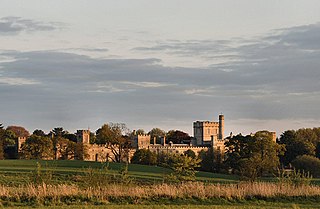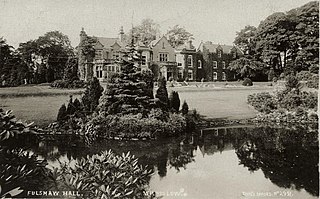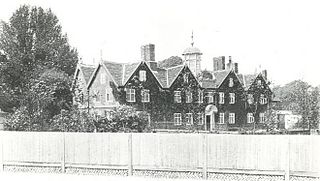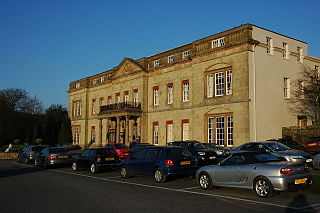
Lyme Park is a large estate south of Disley, Cheshire, England, managed by the National Trust and consisting of a mansion house surrounded by formal gardens and a deer park in the Peak District National Park. The house is the largest in Cheshire, and is recorded in the National Heritage List for England as a designated Grade I listed building.

Wilmslow is a market town and civil parish in the unitary authority of Cheshire East in Cheshire, England, 11 mi (18 km) south of Manchester. The population was 24,497 at the 2011 Census.

Great Moreton Hall is a former country house in Moreton cum Alcumlow near Congleton, in Cheshire, England, less than a mile (1.6 km) from its better-known near namesake Little Moreton Hall. Designed by Edward Blore, it was built in 1841 by Manchester businessman George Holland Ackers, to replace a large timber-framed building that had been the home of the Bellot family since 1602. Great Moreton Hall is built in two storeys, interspersed with three and four-storey towers. The service wing to the left of and adjoining the main part of the building is slightly lower than the rest of the structure.

Handforth Hall is a former manor house in Handforth, Cheshire, England. It is dated 1562, and was built by Sir Urian Brereton. Alterations have been made to it in the 17th century, and subsequently. The hall is a timber-framed building and currently consists of a single range, with two storeys and five bays. Originally it was either E-shaped or quadrilateral in plan. The hall is recorded in the National Heritage List for England as a designated Grade II* listed building. It was at one time the home of Sir William Brereton, a Parliamentary commander in the English Civil War.
Edge Hall is a 9 bedroom, country house located at Hall Lane, Brasseys Contract Road, Edge, Cheshire, SY14 8LE, England. The house is recorded in the National Heritage List for England as a designated Grade II* listed building. It was the ancestral home of the Dod family from the twelfth century to the early twenty first century. The core of the house dates from about 1600. The main part of the building dates from 1721, and additions have been made from about 1790, and later. Its architectural style is Jacobean. The house is constructed in brick, standing on stone plinths, and has a slate roof.
Radbroke Hall is a white French chateau-style former country house in Peover Superior, Cheshire, England. It takes its name from the Red Brook stream that runs through the grounds.
Bonis Hall is a former country house to the north of Prestbury, Cheshire, England. It was the seat of the Pigot family until 1746, when it was bought by Charles Legh of Adlington. In the early part of the 19th century it was remodelled and used by the Legh family as a dower house. In the early 20th century the exterior was pebbledashed, and castellations were added
It is constructed in brick, with Kerridge stone-slate roofs. The house is in two storeys and has a seven-bay front with coped gables surmounted by ball and urn finials. On top of the building is a square tower with a pyramidal roof surmounted by a hexagonal bellcote with a copper cupola and weathervane. It is recorded in the National Heritage List for England as a designated Grade II listed building.

Bostock Hall is a country house to the northeast of Winsford, Cheshire, England. A former Georgian house, it was rebuilt in 1775 for Edward Tomkinson. It is thought that the architect was Samuel Wyatt. Alterations and additions were made to it in the middle of the 19th century and in 1875. The house is constructed in brick with ashlar dressings; it has a slate roof. It is in three storeys plus a basement. Its plan is L-shaped. The entrance front has a central bow window rising through all floors, and a single-storey porch with a balustraded parapet. The garden front has two bows, between which are a Venetian window with a Diocletian window above. The house is recorded in the National Heritage List for England as a designated Grade II* listed building.
Buglawton Hall is a former country house, later a school, to the northeast of Buglawton, a suburb of Congleton, Cheshire, England.

Calveley Hall is a country house to the west of the village of Milton Green, Cheshire, England. It was built in 1684 for Lady Mary Calveley. After Lady Mary's death the estate passed by marriage to the Leghs of Lyme. In 1818 it was remodelled for Thomas Legh, and further alterations have been carried out during the 20th century.

Checkley Hall is a small country house in the parish of Checkley cum Wrinehill, Cheshire, England. The house was built in 1694 by the Delves family of Doddington, replacing an earlier timber-framed house. It was altered in the late 18th or early 19th century, replacing a hipped roof with an attic. The house is constructed in brick with a tiled roof. It has 2½ storeys, and an entrance front with five bays. The house is recorded in the National Heritage List for England as a designated Grade II* listed building. Its gate piers are listed at Grade II.

Fulshaw Hall is a country house, south of the civil parish of Wilmslow, in Cheshire, England. It is recorded in the National Heritage List for England as a designated Grade II listed building.

Hawthorn Hall is a former country house in Hall Road, Wilmslow, Cheshire, England. It originated in about 1610 as a timber-framed yeoman house for John Chavman of mnc. It was improved and encased in brick for John Leigh in 1698. Its use changed in the 19th century, and in 1835 it opened as a homeless shelter school. During the 1960s the house served as a private residence. The building has since been used as offices. It is constructed in plum-coloured brick, with a Kerridge stone-slate roof, a stone ridge, and three brick chimneys. Parts of the timber-framing can still be seen in the roof gables, and in an internal wall. The plan consists of a long rectangle. The house is in 2½ storeys, and has a near-symmetrical north front. There are four gables with bargeboards and mace finials. Each gable contains a pair of wooden mullioned and transomed windows. In the centre is a doorway, flanked by plain pilasters, and surmounted by a segmental hood framing a cartouche containing the date 1698. At the top of the hall, above the door, is a small balustrade, behind which is a half-glazed lantern with a cupola and a weathervane. The south front is similar to the north front, although the door is not central. This door is flanked by fluted pilasters, and surmounted by a plaque with a lion rampant. The east front has two gables. The architectural historian Nikolaus Pevsner comments that the house is "good to look at, though conservative for its date". The house, together with parts of the garden walls, is recorded in the National Heritage List for England as a designated Grade II* listed building.
Oughtrington Hall was a country house located in Oughtrington Lane to the east of the village of Lymm in Cheshire, England.

Over Tabley Hall is a country house in the parish of Tabley Superior in Cheshire, England. It stands in an isolated position to the northwest of junction 19 of the M6 motorway.

Shrigley Hall is a former country house standing to the northwest of the village of Pott Shrigley, Cheshire, England. It has since been used as a school, when a chapel was added, and later as a hotel and country club operated by The Hotel Collection.
Tytherington Old Hall is a former country house in the Tytherington area of Macclesfield, Cheshire, England. It was built in the late 16th century for the Worth family. The building was much altered during the 20th century, and as of 2010 was in use as an office. Since 2006, it has been renovated and converted to a family home. The house is constructed in timber framing on a stone plinth with stone-flagged roofs. The timber-framing includes close studding and herringbone decoration. It is recorded in the National Heritage List for England as a designated Grade II listed building.
Willot Hall is a country house in the parish of Prestbury, some 4.5 km to the east of Wilmslow, Cheshire, England. It originated as a medieval hall house in the later part of the 15th century. This was encased in stone in the 17th century. Later in the century a service wing was added. The house was restored and extended between 1933 and 1939, moving the entrance and reopening the great hall to the roof. It is constructed partly in buff sandstone rubble and partly in brick, with Kerridge stone slate roofs. It is in 2½ storeys, with a four-bay entrance front, the left bay being larger than the others. The left bay contains mullioned windows and is gabled. The other bays contain a doorway, smaller mullioned windows, and gabled dormers. The house is recorded in the National Heritage List for England as a designated Grade II* listed building.
Wilmslow is a town and civil parish in Cheshire East, England. The area, including the parishes of Handforth and Styal, contains 81 buildings that are recorded in the National Heritage List for England as designated listed buildings. Of these, one is listed at Grade I, the highest grade, eight are listed at Grade II*, the middle grade, and the others are at Grade II. The town has grown from a village to encompass some of the surrounding settlements to become a dormitory town for Manchester. Buildings listed within the town include the church and associated structures, a bridge, and former weavers' cottages. Also in the area is the village of Styal that was developed to house the workers at Quarry Bank Mill. The mill, associated structures, and many of the cottages in the village are listed. Elsewhere the listed buildings include country houses and associated structures, farms and farm buildings, bridges, public houses, chapels, and a viaduct.

Ball Farm is the oldest surviving building in the village of Hankelow, near Audlem in Cheshire, England, and is thought to date from 1510. Most of its original timber frame was replaced by brick in the 19th century, but some close studding and small framing survives, as well as part of a mullioned-and-transomed window. Ball Farm was occupied by the Hassalls, a prominent local family, and might have once been used as a district court of justice. It is listed at grade II* by the Historic Buildings and Monuments Commission for England, the middle of the three grades, denoting "particularly important buildings of more than special interest".












